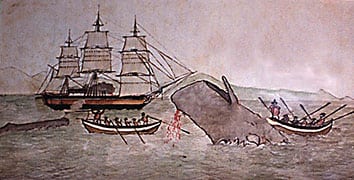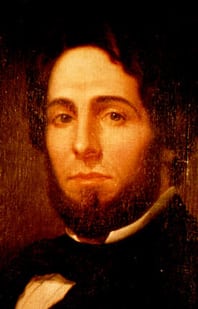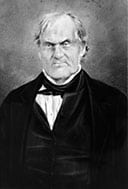To commemorate the 150th anniversary of the publishing of Herman Melville’s book Moby-Dick in 2001, a number of museums revisited the story and the nation’s whaling heritage. Publishers came out with new editions of the classic book. The following article appeared in the Vineyard Gazette on June 29, 2001. The Vineyard Gazette is a weekly newspaper published on Martha’s Vineyard. What follows is a variation from the original with some improvements and some additions. The original article was copyrighted by the Vineyard Gazette.
Whaling and Herman Melville are of particular interest to me. My grandmother was a Pease and her grandfather was an Edgartown Judge, Joseph Thaxter Pease, a relative and known associate of Capt. Valentine Pease. You’ll soon find why Valentine Pease is of interest to all of us.
Moby-Dick and Martha’s Vineyard: Island Played Role in Great Literary Work
By Mark Alan Lovewell ©
Herman Melville probably didn’t set foot on Martha’s Vineyard before he wrote the classic book Moby-Dick, still he was fully aware of the Vineyard and its legacy, its link to the era of whaling.
Much has been written about the Island and its presence in the book. Tashtego, the Indian harpooner in Melville’s tale, came from Gay Head. “The third mate was Flask, a native of Tisbury in Martha’s Vineyard.” Melville described Flask as “a short, stout, ruddy young fellow, very pugnacious concerning whales, who somehow seemed to think that the great Leviathans had personally and hereditarily affronted him.”
Many links exist between the great author of fiction and the Vineyard, before and after the writing of the book. Surprisingly it is only known that Melville spent a few days on the Vineyard, a year after Moby-Dick was published.
Thomas Goethals, 81, lives off Lambert’s Cove Road in West Tisbury. He is an avid and enthusiastic Vineyard authority on Melville. A retired college professor, he has taught at Columbia College, Sarah Lawrence College and the City University of New York. Beginning in 1974, he founded and for 17 years ran The Nathan Mayhew Seminars. On the side, Mr. Goethals focused his attention and love of literature on developing the Vineyard connection to Moby-Dick, for a good part of Island history is tied up in the whaling era.
Mr. Goethals’ grandfather, George W. Goethals, was the chief engineer for the building of the Panama Canal, and spent summers on the Vineyard when Tom was a boy. The American Legion hall in Tisbury is named after his grandfather.
Mr. Goethals is a descendant of two New Bedford whaling families, the Rodman and Rotch families. And there are links back to selectman William Rotch, who engineered the secession of West Tisbury from Tisbury.
“I wanted a great book for a course on Island studies,” Mr. Goethals said. “That is what got me so interested in Moby-Dick.”
To rephrase a quote from the book, Mr. Goethals described Moby-Dick by saying: “Melville’s Moby-Dick is a grand, ungodly godlike book.” His quote comes from Captain Peleg, who described Captain Ahab as a “grand and ungodly, godlike man.” “How can you not love Moby-Dick?” Mr. Goethals asked. It is the history of a great era for the Vineyard, Nantucket and New Bedford. It is about survival, about evil juxtaposed against good. It is about the lives of men facing great adversity. “One of the reasons it is a good book is that it can stand rereading,” he said.
There are characters within the book that have been raised to mythic level. “There is Captain Ahab and his monomaniacal search for what he thinks is truth. The whole question of good and evil are on his mind. You’ve got this captain juxtaposed against a sweet and passive Ishmael. We never know Ishmael’s real name. He begins the book: ‘Call me Ishmael.’ “The whole theme of the book is diving deep, diving to find the mysteries. What is this great creature, this white mammal? This mammal that breathes, takes a gulp of air and goes down to the depths of the sea?” Mr. Goethals said.
The whaling era was a time of great industry and accumulation of wealth. The clearest and largest signs of that industry can be found in downtown Edgartown, in two of the town’s dominating structures: The Old Whaling Church on Main street and the Federated Church on South Summer.
“Herman Melville was a genius. He wrote the book when he was 31 years old. He had just bought the farm up in Arrowhead, not far from Pittsfield,” Mr. Goethals said. He wrote the book in one and a half years.”
Readers will always wonder how a fiction writer gets his ideas, just as Vineyarders will always want to know who played parts in the making of the movie Jaws. Among the great stories of the early 1800s is the maritime disaster of the great whaling ship Essex, which was rammed and sunk by a whale. There were stories of mysterious white whales swimming the sea, stories of crazed captains. Even though Melville is not known to have set foot on the Vineyard prior to writing this book, his life was most certainly affected by people of this Island and the stories of their adventures that circulated around the globe.
Melville based a good part of his writings on his experiences. As a young man, he went to sea on several ships.
Four days after Christmas, on a cold day in December of 1840, Herman Melville, 21, signed his name on the list of men composing the crew of the whaling ship Acushnet of Fairhaven. Valentine Pease, 43, of Edgartown was captain of the vessel.
And this is where the strongest link arises between Moby-Dick and the Vineyard. Historians have spent the last 150 years wondering just how close Captain Pease was to Melville’s Captain Ahab. Certainly, Melville served under no other whaling captain in his short career as a seaman so it begs the question.
Built in 1840, Acushnet sailed on its maiden voyage to the south seas from New Bedford on Jan. 3, 1841.
Eighteen months later, on July 9, 1842, it is recorded in a Hawaiian document that and a fellow member of the crew jumped ship at Nukehiva in the Marquesas. In Melville’s almost autobiographical story Typee, scholars think they found a profile of the Vineyard captain. Melville wrote about life aboard the fictional whaling ship Dolly: “The usage on board of her was tyrannical; the sick had been inhumanly neglected; the provisions had been doled out in scanty allowance; and her cruises were unreasonably protracted. The captain was the author of these abuses; it was vain to think that he would remedy them or alter his conduct which was arbitrary and violent in the extreme. His prompt reply to all complaints and remonstrances was the butt end of a hand spike so convincingly administered as effectually to silence the aggrieved party.” The actual voyage of the Acushnet lasted four and a half years, and in that time half the crew jumped ship. They complained the captain was ill, bad-tempered and dictatorial.
Descendants of the Pease family here have always been uncomfortable over the relationship between the true Valentine Pease and the fictional Captain Ahab. Who would want to be a descendant of so mean-spirited a fellow? In town, Captain Pease was widely known as a fine old man, a gardener, a local statesman in town, referred to as “Uncle Val” on the waterfront. Edgartown was full of members of the Pease family who had the respect of townspeople. Why not this one?
Valentine Pease was born near Caleb’s Pond on Chappaquiddick, Nov. 22, 1797.
Henry Beetle Hough, the editor of the Vineyard Gazette, wrote in 1929:
“Chappaquiddick seems to have existed for the sole purpose of breeding whalemen. There is extant a list of 44 masters, 12 of whom were Peases who were born and raised on the Island in the principal era of whaling.
“Unfortunately there is nothing left (except what Melville has written) to account for Captain Valentine’s career at sea. There have been many searches for the log of the Acushnet, but the result has always been the reluctant assumption that the invaluable log must have been destroyed.”
Captain Pease married Prudence Ripley on June 12, 1828.
Mr. Hough wrote: “There is no doubt that Captain Valentine had achieved the ambition of whalemen. He had made his fortune. The first thing he did was to provide for himself a roomy house. The whaling captains’ houses of Edgartown are not of great size when compared with the mansions of the mainland, but they have a sort of thrifty opulence and contrast with the simpler dwellings of the older era.”Acushnetwhaleship
Soon after completing his voyage aboard the Acushnet, in 1846, the captain retired. “Ashore for good, Captain Valentine went into business in a small way. During most of his life the fires of Edgartown had consumed wood brought from up-Island or gathered along the shore, but now the time of coal had arrived. Accordingly Captain Valentine once a year bought a vessel load of coal, unloaded it and distributed it to those who had placed orders. He kept no office and no coal yard. Once the annual load was gone business was over until the following year.”
Mr. Hough did visit and interview Alexander Pease, a nephew of the late whaling captain, at his home in a suburb of Boston. When asked whether Captain Pease was a bad man, Alexander Pease said: “No, I don’t recall that Uncle Val was a harsh man. I should say he was an upright man, though at times quite profane.”
Captain Pease was married a second time in 1846, to Angeline Worth Bunting, a widow of Edgartown, in the same year that the Vineyard Gazette was founded.
“Oh, there wasn’t anything particular about him. He was a big man, quite tall. He looked like any other whaling captain,” is how the captain’s nephew described him, according to Mr. Hough.
“He is pictured as a powerful, well-built man with side whiskers,” Mr. Hough wrote.
The captain’s death on Sept. 9, 1870, was the only recorded mention of his name in the Gazette: “Died, Valentine Pease, master mariner, at his home, aged 72 years, 9 months and 11 days.” A nondescript stone marks his grave at the Edgartown cemetery. Melville’s connection to the Vineyard did not end with the publishing of Moby-Dick.
A year after the publication of his novel, Melville came to Southeastern Massachusetts on a trip with his father in law, Judge Lemuel Shaw, chief justice of the State Supreme Court. Records show they spent but three days on the Vineyard, from Friday, July 9, to Monday, July 12. There is no evidence Melville got together with the old captain, though the speculation will never rest.
The judge wrote a letter to his son: “Friday morning to the boat, and landed at Martha’s Vineyard. We visited various parts of the island including that celebrated promontory at the west end called Gay Head, through a tract of Indian territory. We remained at the Vineyard till Monday morning.”
Stories have circulated through the years on this Island that after the publication of Moby-Dick, Melville and Captain Pease were later to be friends. Melville’s biographer, however, never substantiated this rumor.
“They never met after Melville jumped ship, as far as is known. That is a myth,” said Hershel Parker, author of the two-volume biography of Melville, speaking from his home in Morro Bay, Calif., this week.
The captain’s possible relationship with the author after the book was published had a way of persisting with the family, however.
Herman Melville had but one surviving daughter; her name was Frances and she married Henry B. Thomas. The two bought a summer house on South Water street in 1908 from Miss Mary Pent. Coincidentally, the 190-year-old house turned out to be the former home of Capt. Valentine Pease.
They had four daughters, and Melville’s four granddaughters spent summers on the Vineyard.
“I came there when I was a small child,” said Priscilla Ambrose, 78, of Irvington, Va., the famous author’s great-granddaughter. “I was a small child, and stayed at the house for several summers in the 1930s.”
Mrs. Ambrose said: “My mother, Francis Thomas Osborne, granddaughter of Herman Melville, inherited the house along with her three sisters. Later she bought them out and traded the house for another up South Water street.”
Mrs. Ambrose said: “I sailed often with Virginia Besse at the Edgartown Yacht Club.” She and her husband, William, owned a house on Mill street and sold it several years ago. “We made a cut from the Vineyard. It was a sad goodbye for me.”
The family loved their home at 80 South Water street, not far from the center of town and the waterfront. Tourism and the arrival of the automobile was not necessarily a good thing, for they liked a quiet community. Henry B. Thomas, son in law of Herman Melville, wrote a letter to the editor that appeared in the July 22, 1930, edition of the Vineyard Gazette:
“In the Gazette of the 18th, under the heading of Editorial Comment, In Defence of the Summer People, the question is asked, what do the summer people ask of the town? I would suggest that many of them agree that the charm and restful feeling that formerly prevailed in Edgartown has been lost, owing to the speeding of cars through its streets, and it seems that something should be done to put an end to it. For it is not only dangerous but an annoyance that should not be permitted in a well regulated community. Why anyone should find it necessary to travel at thirty to thirty-five miles an hour in town is beyond comprehension.”
He finished his letter saying: “I hope the authorities will take the necessary steps to enforce the lawful speed in the town. It can be, and should be done.”
The life of the Captain Valentine Pease house continues. Today the home belongs to Patricia Neal, a celebrated Hollywood actress.
The public’s fascination with a white whale lived on well beyond the publishing of the book.
Amos Peters Smalley, an Indian from Gay Head, is the only recorded whaler to have earned the distinction of harpooning a white whale, and for his efforts he received national attention. Mr. Smalley was born in 1877 and began his whaling career at the age of 15. On a 1902 trip aboard the barque Platina of New Bedford in the South Atlantic, in an area off the coast of Africa known as the Western Ground, Mr. Smalley harpooned a white sperm whale. A New Bedford Standard Times article that appeared in 1957 reported that Mr. Smalley was honored for having received $2,500 from Readers Digest for his story, entitled I Killed Moby Dick.
The newspaper article said: “Smalley stepped into a 30-foot whaleboat, commanded by the mate, Andy West. This was the boat that was to ‘go on the whale.’ As they drew near the whale, which was 90 feet long, West spoke in a voice Smalley will never forget: ‘That fish is white! He’s white all over. Give it to him!’
“Smalley gave it to him. He got his iron into the great mammal, and the small bomb that trailed it. Finally he heard the bomb explode, the muffled “pung pung” far down inside the creature. Then the whale nearly pulled the boat under.
“‘Suddenly,’ Smalley says, ‘his whole head broke water, the line jerked so it took all of us to hold it, and the air was filled with heavy roar, as thick red blood gushed from his spout-hole.’
“The mate went forward with the shoulder gun ready for more tricks. But there weren’t any. ‘Smalley,’ the mate said, ‘you done well. You put your iron right over his heart. You killed him.’ “
Mr. Smalley’s death at the age of 84 was recorded in the March 10, 1961, Vineyard Gazette. The correspondent wrote: “Known the Island over by year-round and seasonal residents, Mr. Smalley was popular with everyone. His genial disposition, his gentle manner and natural courtesy won him friends while his Indian ancestry invested him with a quiet dignity which was an ever-present part of his nature.”
Last year, attention shifted back to Moby-Dick with the publishing of the book In the Heart of the Sea, the tragedy of the Whaleship Essex, written by Nathaniel Philbrick of the Nantucket Historical Association. The book was a national bestseller.
The Essex incident occurred in 1821, and there is little doubt why the story found its way into Melville’s plan.
In an interview with the Vineyard Gazette last year, Mr. Philbrick said five months before departing from Nantucket on its fateful trip, the Essex was in Edgartown to unload its whale oil from a previous trip. It was customary in that time for ships to unload their oil here first. The entrance to Nantucket harbor was too shallow to accommodate the fully-loaded whaleships. The Essex was in Edgartown in April of 1819.
In that year 2001, seaside communities observed the 150th anniversary of the publishing of Moby-Dick. At the New Bedford Whaling Museum on Jan. 3, friends gathered for the annual reading of the classic. It took 25 hours and a team of volunteers to read the book from cover to cover without interruption. The observance marked the anniversary of the day Melville sailed out of New Bedford on the Acushnet. Later in the summer the museum offered special programs.
The Nantucket Historical Association had an exhibition called Paintings of Moby-Dick that was shown that summer and in November they hosted a week-long celebration called “150 years of Moby-Dick“ which included lectures, concerts and other events.



